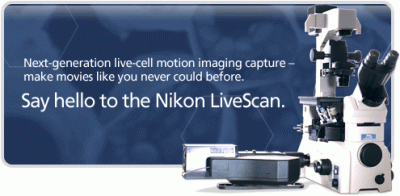Nikon LiveScan SFC Swept Field Confocal Microscope
Nikon Updated: 2007-06-19Combining the advantages of confocal imaging with the versatility of conventional live cell microscopes.
The Nikon LiveScan Swept Field Confocal Microscope (SFC) enables dynamic live cell confocal imaging through an innovative new optical design that combines pinhole and slit scanning modes into one microscope. Slit scanning produces faster acquisition, while pinhole mode produces higher spatial resolution. Now researchers have the imaging power and flexibility to choose the scanning feature that best suits the application at hand.
Swept Field Technology
Whether you're doing multi-dimensional imaging of cells (X,Y,Z,T or even X,Y,Z,T at multiple coordinates), observing fast neural events, or looking to capture live-motion images of cells, the Nikon LiveScan SFC (Swept Field Confocal) microscope offers advanced technology for your advanced research.
Unlike confocal systems with fixed-size pinhole apertures, the Nikon LiveScan SFC lets users choose the pinhole or slit size to match their objective lens. Galvanometric and piezo controlled mirrors sweep the image of the pinholes or slit across the sample, while the aperture itself remains motionless. The emission photons are directed through a complementary set of pinholes or a slit onto a CCD camera. By separating the excitation and emission lightpaths, keeping the aperture motionless, and by using a linear aperture array, the LiveScan SFC dramatically reduces crosstalk and noise while at the same time allowing for maximum flexibility.
Overcoming the Limitations of Traditional Field Scanning Confocal Systems
The “swept field” technology overcomes many of the limitations of traditional confocal systems, such as a lack of synchronization between moving pinholes and the CCD camera, crosstalk between pinholes, and a limited selection of objective lenses. Because the LiveScan has selectable aperture sizes, several objective lens magnifications and numerical apertures can be used for maximum resolution.
In addition, users can control the acquisition time and laser exposure with NIS-Elements software control, as well as the frequency and duration of each “sweep” of the scanner, allowing for maximum flexibility in scanner control.
Nikon LiveScan SFC offers three selectable confocal pinhole diameters (from 30µm to 60µm), along with four slit scanning modes (22um to 70µm), so you can choose to optimize sensitivity, resolution, and speed based on your experimental needs.
True Hybrid Design
Nikon’s LiveScan SFC (Swept Field Confocal) Microscope combines the use of both size selectable linear arrays of fixed pinholes or slits to provide maximum flexibility of both speed and resolution.
Selectable confocal pinhole diameters permit users to select the pinhole that best matches their imaging requirements, maximizing performance by allowing a meaningful choice between sensitivity and resolution. If very high temporal resolution is required, SFC can be used in slit scan mode with four slit widths available.
A hybrid system design combines tandem scanning technology with galvanometric sweeping. Apertures remain motionless (no synchronization artifact), while the galvanometric mirror sweeps an array of points across the specimen. Points are then “re-swept” to the camera to form an image. The highly efficient optical system captures a greater proportion of photons than conventional technology, with reduced back reflections from incoming light, crosstalk, and noise.
The stationary pinhole apertures eliminate the distortions observed at high frame frequencies with other field scanning confocal systems. You can also change pinhole sizes to choose the best diameter to match your objective’s magnification and numerical aperture. The innovative technology and flexibility result in exceptionally clear and detailed moving images.
High-Speed
Frame rates of up to 100 frames per second (fps) in pinhole mode and up to 1000 fps in slit mode are possible*, with selection of an appropriate camera. Ideal for live samples, the frequency of scanning is very short, minimizing the effects of photobleaching and phototoxicity.
* frame rates are dependent on the readout speed of the detector used
Maximum Resolution
Three pinhole choices allow the appropriate size pinhole to be selected for a variety of objective lenses. In pinhole mode, the LiveScan SFC offers similar axial resolution to that of a point scanning confocal.
Multiple Laser Configurations
Up to 6 laser lines are available.
Multiple Detector Choices
Compatible with a variety of cameras, including Nikon DQC-FS , Roper Coolsnap HQ2 and Roper Cascade 128+.
Intuititve and Powerful Software
The LiveScan SFC is fully integrated into Nikon's NIS-Elements imaging software, making the system easy to use and control, and offering many features, including 6D acquisition, high speed Z acquisition, high speed multi-excitation, 2D real-time deconvolution, user-friendly macro function, and a variety of image processing and measurement functions.
Nikons Full Line of Confocal Products
LiveScan SFC
Related Manuals
Nikon Eclipse C1 Plus Confocal Microscope System
Nikon SMZ1500 Zoom Stereomicroscope
Nikon Eclipse C1si Confocal Microscope System
Nikon SMZ1000 Zoom Stereomicroscope
Nikon MM400/800 Industrial Measuring Microscopes
Nikon SMZ800 Zoom Stereomicroscope
Nikon NWL-641 IC Inspection Wafer Loader
Nikon SMZ645/660 Zoom Stereomicroscope
Nikon Eclipse 50i POL Polarizing Microscope
Nikon NWL-860 IC Inspection Wafer Loader
Nikon Eclipse LV100 POL Polarizing Microscope
Nikon Eclipse L200 Series IC Inspection Microscopes
